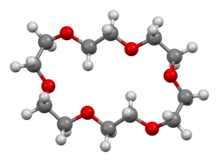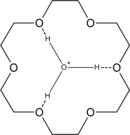 | |
 | |
 | |
| Names | |
|---|---|
| Preferred IUPAC name 1,4,7,10,13,16-Hexaoxacyclooctadecane | |
| Identifiers | |
| CAS Number | |
| 3D model (JSmol) | |
| Beilstein Reference | 1619616 |
| ChEBI | |
| ChEMBL | |
| ChemSpider | |
| ECHA InfoCard | 100.037.687 |
| EC Number |
|
| Gmelin Reference | 4535 |
| PubChem CID | |
| UNII | |
| CompTox Dashboard (EPA) | |
InChI
| |
SMILES
| |
| Properties | |
| Chemical formula | C12H24O6 |
| Molar mass | 264.315 g/mol |
| Density | 1.237 g/cm |
| Melting point | 37 to 40 °C (99 to 104 °F; 310 to 313 K) |
| Boiling point | 116 °C (241 °F; 389 K) (0.2 Torr) |
| Solubility in water | 75 g/L |
| Hazards | |
| GHS labelling: | |
| Pictograms | 
|
| Signal word | Warning |
| Hazard statements | H302, H315, H319, H335 |
| Precautionary statements | P261, P264, P270, P271, P280, P301+P312, P302+P352, P304+P340, P305+P351+P338, P312, P321, P330, P332+P313, P337+P313, P362, P403+P233, P405, P501 |
| Related compounds | |
| Related compounds | Dibenzo-18-crown-6 Triglyme Hexaaza-18-crown-6 |
| Except where otherwise noted, data are given for materials in their standard state (at 25 °C , 100 kPa).
| |
18-Crown-6 is an organic compound with the formula 6 and the IUPAC name of 1,4,7,10,13,16-hexaoxacyclooctadecane. It is a white, hygroscopic crystalline solid with a low melting point. Like other crown ethers, 18-crown-6 functions as a ligand for some metal cations with a particular affinity for potassium cations (binding constant in methanol: 10 M). The point group of 18-crown-6 is S6. The dipole moment of 18-crown-6 is solvent- and temperature-dependent. Below 25 °C, the dipole moment of 18-crown-6 is 2.76 ± 0.06 D in cyclohexane and 2.73 ± 0.02 in benzene. The synthesis of the crown ethers led to the awarding of the Nobel Prize in Chemistry to Charles J. Pedersen.
Synthesis
This compound is prepared by a modified Williamson ether synthesis in the presence of a templating cation:
(CH2OCH2CH2Cl)2 + (CH2OCH2CH2OH)2 + 2 KOH → (CH2CH2O)6 + 2 KCl + 2 H2O
It can be also prepared by the oligomerization of ethylene oxide. It can be purified by distillation, where its tendency to supercool becomes evident. 18-Crown-6 can also be purified by recrystallisation from hot acetonitrile. It initially forms an insoluble solvate. Rigorously dry material can be made by dissolving the compound in THF followed by the addition of NaK to give Na, an alkalide salt.
Crystallographic analysis reveals a relatively flat molecule but one where the oxygen centres are not oriented in the idealized 6-fold symmetric geometry usually shown. The molecule undergoes significant conformational change upon complexation.
Reactions

18-Crown-6 has a high affinity for the hydronium ion H3O, as it can fit inside the crown ether. Thus, reaction of 18-crown-6 with strong acids gives the cation . For example, interaction of 18-crown-6 with HCl gas in toluene with a little moisture gives an ionic liquid layer with the composition , from which the solid can be isolated on standing. Reaction of the ionic liquid layer with two molar equivalents of water gives the crystalline product .
Applications

18-Crown-6 binds to a variety of small cations, using all six oxygens as donor atoms. Crown ethers can be used in the laboratory as phase transfer catalysts. Salts which are normally insoluble in organic solvents are made soluble by crown ether. For example, potassium permanganate dissolves in benzene in the presence of 18-crown-6, giving the so-called "purple benzene", which can be used to oxidize diverse organic compounds.
Various substitution reactions are also accelerated in the presence of 18-crown-6, which suppresses ion-pairing. The anions thereby become naked nucleophiles. For example, using 18-crown-6, potassium acetate is a more powerful nucleophile in organic solvents:
- OAc + C6H5CH2Cl → C6H5CH2OAc + Cl
The first electride salt to be examined with X-ray crystallography, ·e, was synthesized in 1983. This highly air- and moisture-sensitive solid has a sandwich molecular structure, where the electron is trapped within nearly spherical lattice cavities. However, the shortest electron-electron distance is too long (8.68 Å) to make this material a conductor of electricity.
References
- ^ Steed, Jonathan W.; Atwood, Jerry L. (2009). Supramolecular Chemistry (2nd ed.). Wiley. ISBN 978-0-470-51233-3.
- Caswell, Lyman R.; Savannunt, Diana S. (January 1988). "Temperature and solvent effects on the experimental dipole moments of three crown ethers". J. Heterocyclic Chem. 25 (1): 73–79. doi:10.1002/jhet.5570250111.
- ^ Gokel, George W.; Cram, Donald J.; Liotta, Charles L.; Harris, Henry P.; Cook, Fred L. (1977). "18-Crown-6". Org. Synth. 57: 30. doi:10.15227/orgsyn.057.0030.
- Jilek, Robert E.; Fischer, Paul J.; Ellis, John E. (2014). "Bis(1,2-Bis(Dimethylphosphano)Ethane)Tricarbonyltitanium(0) and Hexacarbonyltitanate(2−)". Inorganic Syntheses: Volume 36. Vol. 36. pp. 127–134. doi:10.1002/9781118744994.ch24. ISBN 9781118744994.
- Dunitz, J. D.; Seiler, P. (1974). "1,4,7,10,13,16-Hexaoxacyclooctadecane". Acta Crystallogr. B30 (11): 2739. doi:10.1107/S0567740874007928.
- Atwood, Jerry L.; Bott, Simon G.; Coleman, Anthony W.; Robinson, Kerry D.; Whetstone, Stephen B.; Means, C. Mitchell (December 1987). "The oxonium cation in aromatic solvents. Synthesis, structure, and solution behavior of ". Journal of the American Chemical Society. 109 (26): 8100–8101. doi:10.1021/ja00260a033.
- Atwood, Jerry L.; Bott, Simon G.; Means, C. Mitchell; Coleman, Anthony W.; Zhang, Hongming; May, Michael T. (February 1990). "Synthesis of salts of the hydrogen dichloride anion in aromatic solvents. 2. Syntheses and crystal structures of and the related ". Inorganic Chemistry. 29 (3): 467–470. doi:10.1021/ic00328a025.
- Liotta, C. L.; Berknerin, J. (2004). "18-Crown-6". In Paquette, L. (ed.). Encyclopedia of Reagents for Organic Synthesis. New York: J. Wiley & Sons. doi:10.1002/047084289X.rc261. ISBN 0471936235.
- Wynn, David; et al. (1984). "The Solubility of Alkali-Metal Fluorides in Non-Aqueous Solvents With and Without Crown Ethers...". Talanta. 31 (11): 1036–1040. doi:10.1016/0039-9140(84)80244-1. PMID 18963717.
- Cook, Fred L.; Bowers, Chauncey W.; Liotta, C. L. (November 1974). "Chemistry of naked anions. III. Reactions of the 18-crown-6 complex of potassium cyanide with organic substrates in aprotic organic solvents". The Journal of Organic Chemistry. 39 (23): 3416–3418. doi:10.1021/jo00937a026.
 . For example, interaction of 18-crown-6 with HCl gas in
. For example, interaction of 18-crown-6 with HCl gas in  , from which the solid
, from which the solid  can be isolated on standing. Reaction of the ionic liquid layer with two molar equivalents of water gives the crystalline product
can be isolated on standing. Reaction of the ionic liquid layer with two molar equivalents of water gives the crystalline product  .
.
 ". Journal of the American Chemical Society. 109 (26): 8100–8101.
". Journal of the American Chemical Society. 109 (26): 8100–8101. 

 and the related
and the related  ". Inorganic Chemistry. 29 (3): 467–470.
". Inorganic Chemistry. 29 (3): 467–470.